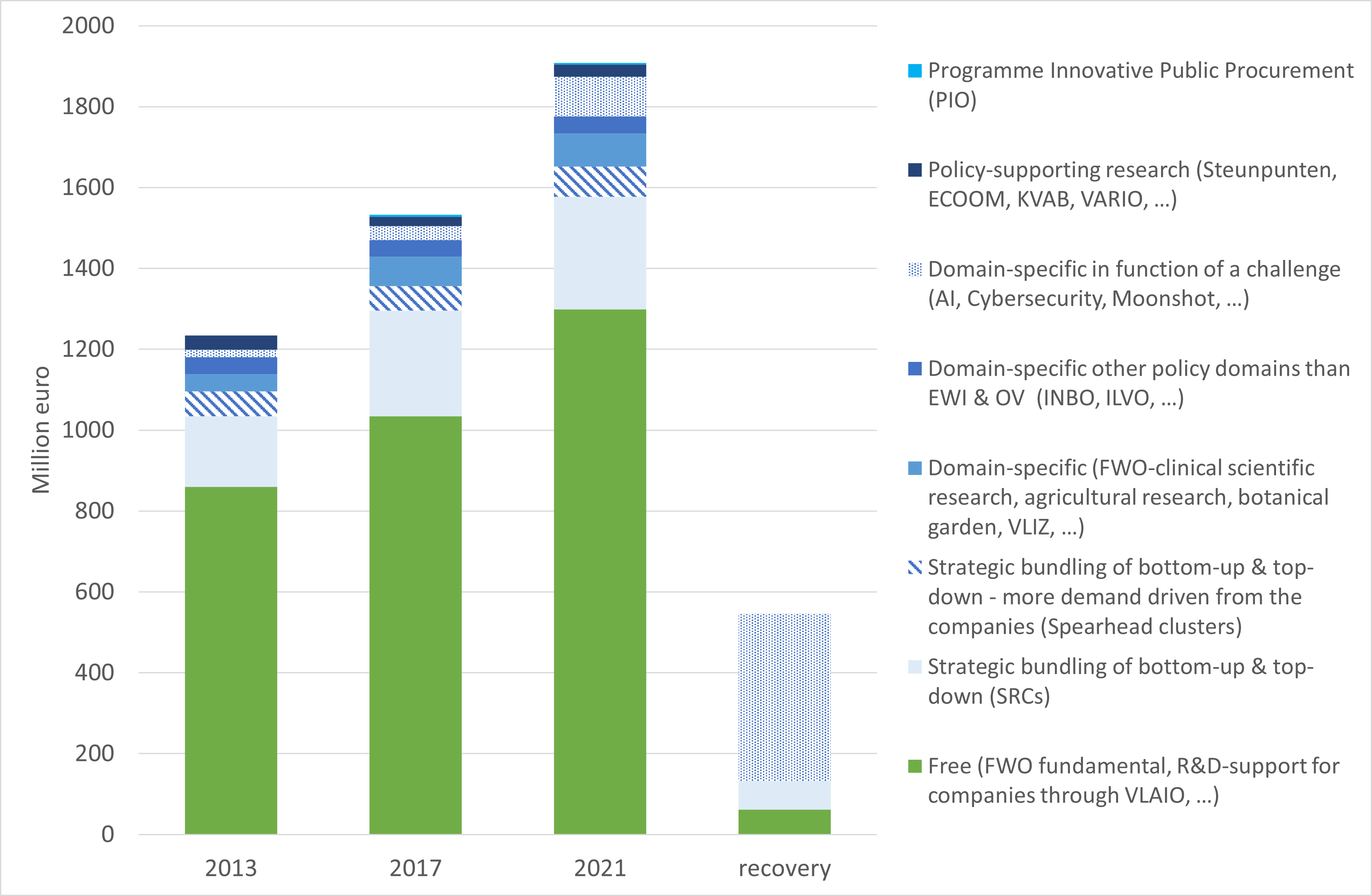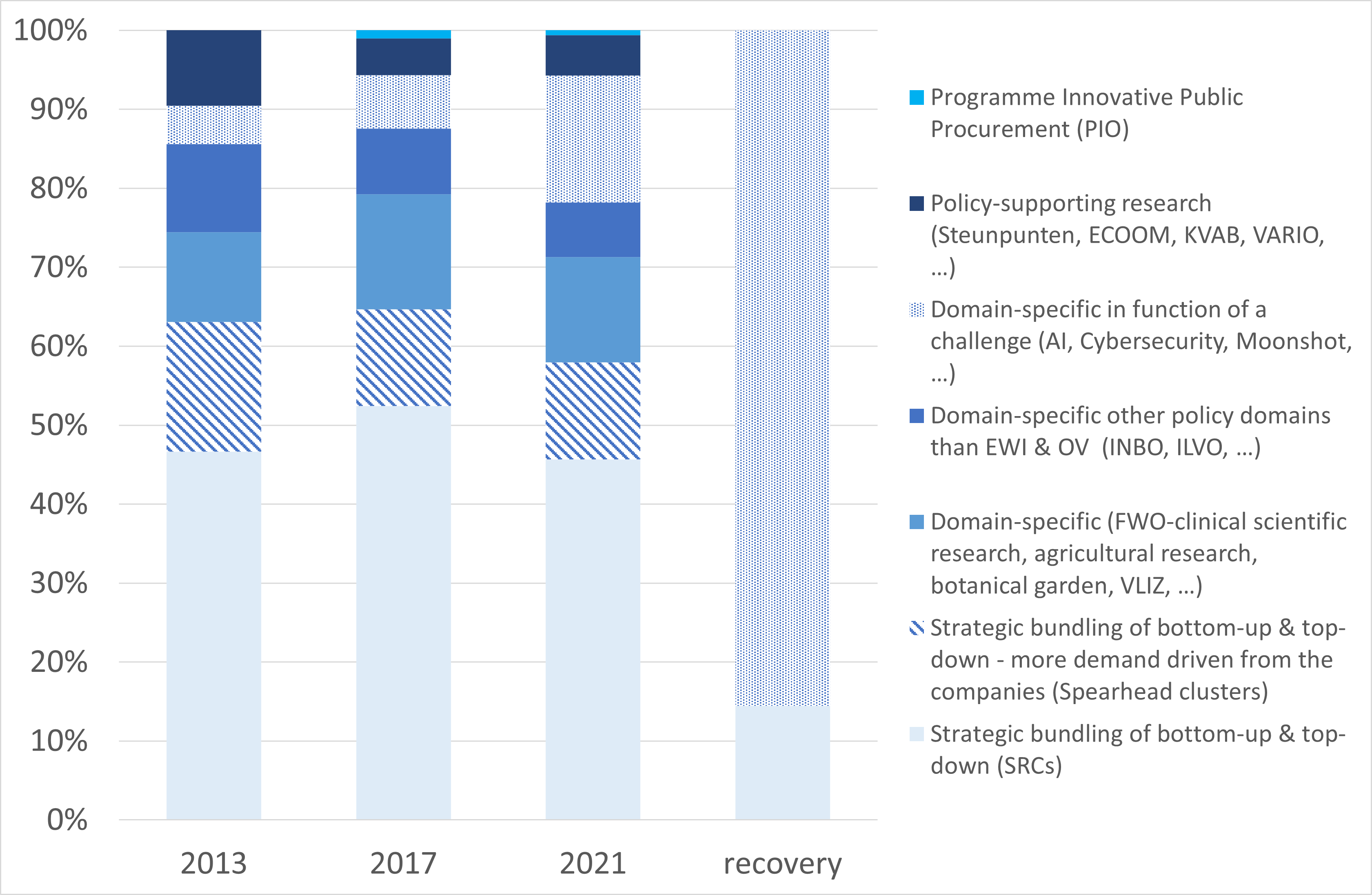Onderstaande printversie van het indicatorenboek werd door uw browser gegenereerd, en zal niet steeds optimaal ogen. Via de ingebouwde printfunctie op de website van het Indicatorenboek (ronde knop rechts bovenaan) kan u een printvriendelijke PDF genereren met mooi ogende lay-out.
7.2.3Results and conclusions
Based on the analysis, a number of observations could be made. Figure 1 shows that, except for the recovery funds, most resources go to free channels. It is moreover clear that almost all categories of Flemish R&D resources have grown in absolute terms over the years. The resources for the category 'Strategic bundling of bottom-up and top-down' (Strategic Research Centres) grew the most between 2013 and 2017. The category that increased the most over the years, and especially between 2017 and 2021, are the resources for 'domain-specific in function of a challenge'. Only the resources for domain-specific research from policy areas other than EWI (Economy, Science and Innovation) and OV (Education and Training) and for policy-supporting research have not increased. For policy-supporting research, there is even a decrease between 2013 and 2017. This is due to the discontinuation of funding for policy research centres from the EWI Department. As VARIO is an advocate of evidence-based policy, the council regrets this decrease in funds.
Figure 1: Overview of the absolute amounts for the different categories of recurrent Flemish R&D resources per year compared and for the recovery resources

With 66,5 to 70% of the total, bottom-up funds make up the largest share across all years (Figure 2). A slight decrease over time can be observed for them. This is because the categories of Strategic Research Centres and of 'domain-specific in function of a challenge' have increased proportionally more.
The recovery funds are very clearly used more top-down than the regular funds. Moreover, this is an underestimate because it does not yet consider budget shifts from the free resources (R&D business support) to thematic (domain-specific in terms of a challenge), in the framework of the Important Projects of Common European Interest (IPCEI). The strong top-down emphasis in the recovery is logical since it concerns investment resources in the domains prescribed by the European Commission. It could be a harbinger of the future, if (part of) the projects/programmes from it that are not deployed for infrastructure, are perpetuated. However, if considered that budgets of the recovery can be spent over six years, they change very little to the proportions of the different categories when they are counted up with the regular resources. Free resources in that case still maintain a large preponderance.
VARIO has recommended that ratios from the recovery may not be extended to the regular R&D funds in the future and that bottom-up resources should be preserved and nurtured. According to the council, it is essential that sufficient thematically free resources are retained, both for companies and for knowledge institutions. In the long term, such resources can give rise to radical innovations that allow us to face up to societal challenges.
Figure 2: Overview of the proportions of the distinct categories of recurrent Flemish R&D funds by compared year and for the recovery funds. The large cyclical budgets of the FWO (Odysseus and Excellence of Science Programmes) are divided proportionally over the years in which they can be used

The budgets for the Strategic Research Centres are proportionally the most important thematic resources for all years (Figure 3). They make up just over half of the thematic resources for 2017, slightly less than half in 2013 and 2021. The strong increase in 2017 can be attributed to, on the one hand, a strong increase in the endowments for imec and VIB and, on the other hand, the creation of a new SRC, Flanders Make, with associated financial resources. If the thematic resources are looked at separately, the strong increase in funds in function of a challenge again stands out. Another change over time that can be noted is the drop in budget for the clusters ('Strategic bundling bottom-up & top-down - more demand-driven from companies') between 2013 and 2017 due to the disappearance of the budget line ‘Commitment authorisations to support actions of technological innovation at the initiative of the Flemish Government’ of 20 million euro. New in the statistics in 2017 versus 2013, is the Innovative Public Procurement Programme, which admittedly receives relatively small amounts.
Figure: 3 Overview of the ratios between the distinct categories of thematically driven, recurrent Flemish R&D funds per year compared and for the recovery funds. Here the major cyclical budgets of the FWO (Odysseus and Excellence of Science Programmes) are fully taken into account in the year in which they were allocated

In 2022 there has been a step-up in R&D resources. This step up is mainly top-down. The additional, recurrent resources, 40 million euro in total, mostly go to the Strategic Research Centres. They are divided as follows1:
- Reinforcement and additional activities under the new five year covenants of imec (+15 million euro) and VIB (+10 million euro). The emphasis here is on valorisation of top research via applications for sustainability and care.
- Step up for VLIZ (+1.5 million euro) following the new five year covenant.
- Agreed step up Flanders Make (+6.5 million euro).
- Strengthening of fundamental research FWO (+7.5 million euro), including a solution for excellent researchers after emeritus status.
